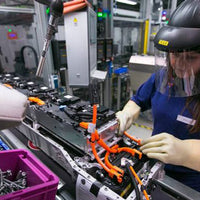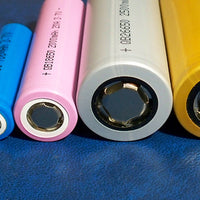Part 2 Grouping inconsistency optimization method
1. Single-cell manufacturing technology
Lithium battery materials
The cathode materials for lithium-ion batteries include ternary materials, lithium iron phosphate, lithium cobaltate, and lithium manganate, and the cathode materials include graphite, silicon, and lithium titanate. The same batch of raw materials is very important for the consistency of battery performance. During the production process, strict control of parameters such as particle size distribution, specific surface area, and impurity content of raw materials is required to ensure the batch consistency of raw materials.
Lithium-ion battery production process
The production process of the battery consists of several processes, and each processing process may affect the consistency of the battery. To produce a consistent performance of the monomer, each process must be reasonably designed and controlled so that it repeats in parallel. The battery production process is designed according to the performance requirements of the battery, and the impact of parameters such as raw materials, electrodes, and electrolyte on the consistency of the battery is analyzed so that the threshold values of each process parameter can be reasonably controlled. Production lines with less human intervention and automation can also improve battery consistency.
2. Sorting system
To reduce the adverse effects of initial state differences on the battery group, it is usually necessary to screen the individual cells and combine the groups with more consistent state parameters. Battery grouping methods mainly include the single-parameter grouping method, multi-parameter grouping method, and dynamic characteristic curve grouping method. The dynamic characteristic curve grouping method can reflect the battery characteristics well by comparing the difference of charge/discharge curves between different batteries at the same magnification, and the sorting effect is ideal.
3. External circuit of the battery pack
Battery series and parallel connection method
The connection method of the battery pack affects the consistency of the battery. There are two better connection methods: connecting two identical batteries in parallel as one module and then connecting the modules in series (PSB); connecting two different batteries in series as one module and then connecting the modules in parallel (SPA).
Battery Management System
To improve the performance and service life of the battery requires the management and maintenance of the single battery. The battery management system is an important guarantee for the normal operation of the battery system, the main task is to ensure the performance of the battery pack, prevent the battery from damage, avoid safety accidents, make the battery work in the appropriate area and extend the life. the BMS consists of sensors, actuators, controllers and signal lines, and other parts, the main functions are data acquisition, state estimation, charge and discharge control, equalization charging, heat management, safety management, and data communication, etc.
Although the battery management technology has been widely used, it still needs to continue to be improved, especially in the areas of SOC estimation and data acquisition accuracy, equalization circuit, and fast battery charging. Due to the differences in the characteristics of different types of batteries, a BMS applicable to all batteries is the main research direction at present.
Equalization control
To alleviate or even eliminate the inconsistency among individual cells in a battery pack and improve the performance, lifetime, and safety of the battery pack, the equalization circuit, and equalization control strategy can effectively improve the inconsistency of the battery pack.
Equalization circuit topology: The research of equalization circuit topology is mainly to design and improve the equalization circuit structure to improve the equalization efficiency and reduce the cost. According to the equalization circuit whether the circuit consumes energy in the equalization process can be divided into energy-consuming equalization and non-energy-consuming equalization. The energy-consuming equalization circuit uses energy-consuming elements to consume the higher voltage battery power in the battery pack to achieve single battery consistency, which is simple, fast, and efficient, but will lead to low energy utilization of the battery pack; the non-energy-consuming circuit uses energy storage elements and equalization external circuit to achieve energy transfer between batteries, which has high energy utilization efficiency, and the non-energy-consuming equalization has switched-capacitor, converter and transformer The non-energy consumption type equalization has switched capacitor, converter, and transformer.
Equalization control strategy: The equalization control strategy is mainly to determine the working mode of the equalization module. At present, the working methods are the maximum value equalization method, mean comparison method, and fuzzy control method. The improvement of equalization capability is an important direction for battery consistency research. The equalization technology needs to be further improved, including.
(1) SOC as the most ideal judgment standard and the real-time estimation accuracy needs to be further improved.
(2) Optimizing the topology of the equalization circuit to improve the equalization speed and shorten the equalization time.
(3) The equalization control strategy still needs to be optimized to determine the best equalization parameters and find the appropriate equalization path to achieve fast equalization according to the equalization circuit.
Most of the research on equalization control strategies at this stage focuses on the design and implementation of equalization hardware circuits. However, the equalization circuit parameters can affect the equalization effect. Also, the state of battery charge at the start of equalization, the equalization threshold, the charge/discharge current, the ratio of equalization current to charge/discharge current, and the way to switch between charge and discharge conditions also affect the equalization effect.
4. Charging and discharging strategy
A scientific and reasonable charging and discharging strategy can improve the efficiency of battery energy utilization. At present, the best comprehensive charging method is the battery management system and charger coordinated with series charging, through the BMS to monitor the ambient temperature of the battery pack, the voltage, and current of the single battery, consistency and temperature rise, etc., and data sharing with the charger to charge the output current in real-time, which can prevent battery overcharge and optimize charging. This charging method is the mainstream at present, which can eliminate to some extent the problems of poor consistency, low charging efficiency, and inability to fully charge the Li-ion battery pack when charging.
5. Battery thermal management
The uneven spatial distribution of heat production and heat dissipation of every single cell in the battery pack will cause the inconsistent temperature of the battery itself, some areas of the battery pack and the environment in which it is located, and if not controlled, the temperature difference inside the battery pack will continue to expand, thus accelerating the battery performance degradation. Therefore, the need for thermal management of the battery pack.
A thermal management system usually requires a compact structure, lightweight, easy to pack, reliable, low cost, and easy to maintenance. Its functions are: to operate the battery in the optimum temperature range; to reduce the temperature difference between cells, within the module, and between the modules. Thermal management is divided into active and passive approaches. The use of thermally conductive media in the system can be divided into three categories, namely air, liquid, and phase change materials.
At present, there are limitations in battery pack thermal management research, such as the over-simplified battery thermal model, the zero-dimensional thermal generation model is often used for the battery monomer, the same thermal generation rate for each part of the battery, and the lack of performance comparison of different thermal management systems based on non-uniform internal heat sources. There is less research on the low-temperature characteristics of lithium-ion batteries and low-temperature thermal management technology.
The reasons for inconsistency in battery formation are mainly the initial differences between single cells and the differences in structure, usage conditions, and environment after battery formation. To alleviate the problems of performance degradation and life reduction brought by battery formation, we can optimize the manufacturing process of batteries to reduce the initial differences of batteries; screen the batteries before battery formation, and group the batteries with less inconsistency; fully consider the influence of connection methods and structures on inconsistency when combining battery group systems; and carry out reasonable battery management, effective equalization as well as thermal management in the process of use to Reduce the inconsistency caused by different usage conditions. Among the technologies to improve battery pack consistency, BMS and thermal management technologies are relatively mature, while SOC estimation accuracy and equalization effect need to be further improved.








0 comments